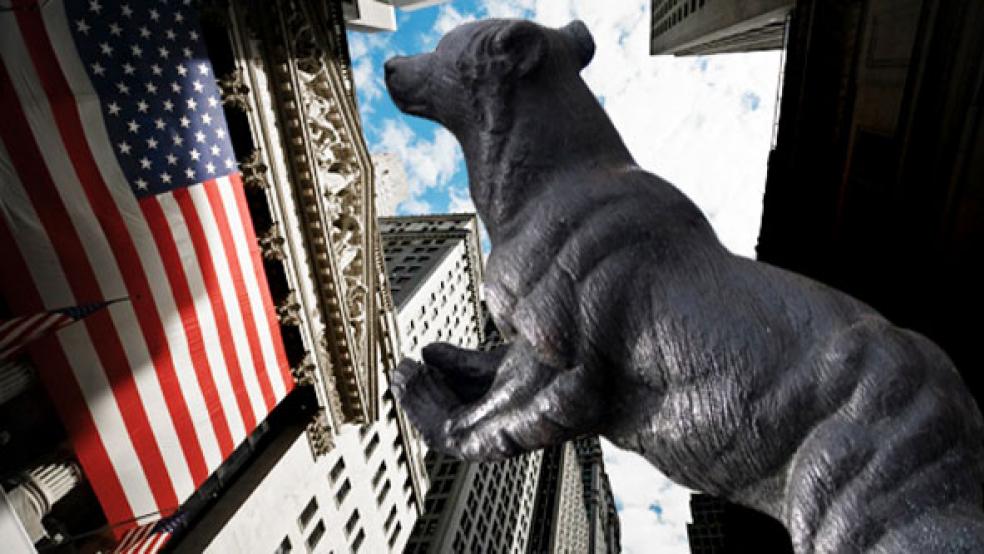The bears continue to hold the upper hand today, as investors focus on a new spate of bad economic news and the subtext of the Fed’s Tuesday’s meeting: a slowing U.S. economy. “Yesterday was a tipping point,” says Nariman Behravesh, chief economist at Global Insight. “There has been a lot of not-so-great news. But finally it pushed many investors over the edge, and we got a mini panic.” But that doesn’t mean stocks go straight down from here. Warns Behravesh: “Markets tend to overreact.”
Yesterday’s wave of selling was fueled by a larger-than-expected increase in initial jobless claims. The Labor Department reported that they rose by 2,000 last week to 484,000, the highest level since mid-February. Adding to the fear of a double-dip recession was Cisco’s announcement that its third quarter revenue could be as low as $10.64 billion, versus analyst expectations of $10.95 billion. That helped send the computer networking giant’s stock down nearly 10 percent, and technology stocks as a group down 1.7 percent. Cisco CEO John Chambers said on a conference call that the company was getting “mixed signals” and seeing “unusual uncertainty” on the economy.
The selling began yesterday in Asia with news of slower growth in China and a disappointing economic indicator in Japan. Then the rout hit Europe and the U.S., where the Commerce Department reported that the U.S. trade deficit had hit a 20-month high in June as exports fell. “June’s U.S. international trade figures suggest that the U.S. economy cannot rely on a boost from overseas demand to offset the current domestic weakness,” says Paul Dales, U.S. economist for Capital Economics. A U.S. higher trade deficit also suggests a downward revision in second quarter GNP growth from the 2.3 percent initially reported to as low as 1 percent to 1.5 percent, says James Swanson, chief investment strategist at Boston-based MFS Investment Management.
Add to that the Fed’s Tuesday announcement that it would continue to hold interest rates low and reinvest maturing mortgage-backed securities in U.S. Treasuries -- a sign that fed policymakers are worried about slow growth and perhaps even deflation -- and you have the recipe for the rout. “There is a concern that the entire global economy is downshifting,” says Moody’s Analytics economist Mark Zandi, and “nervousness” about how few options policymakers have left to jumpstart economic growth.
By market close in New York, the Dow Jones Industrial Average had fallen 265 points, or 2.5 percent, its biggest drop in six weeks, while the broader Standard & Poor’s 500 index fell 2.8 percent, and the technology-heavy NASDAQ slid 3.5 percent. Meanwhile, Treasurys led a rally in government bonds, as investors sought relative safety. And the Chicago Board of Trade’s Volatility Index, known as the market’s fear gauge, rose 14 percent to close at 25.39, the biggest increase since late June. “It’s going to be choppy, especially as we go through this transition to slower growth,” says Brian Bethume, chief U.S. economist with IHS Global Insight.
Are investors overreacting? Perhaps.
Certainly, the economy is slowing down. But there is little evidence that we are headed back into recession. “The risk of a real double dip is way overblown,” says Behravesh. After all, third quarter corporate profits have been stellar and corporations are flush with cash. A key question is: When will they put that money to work? While capital investment and hiring has picked up slightly, they remain anemic. And we haven’t yet seen any surge in mergers and acquisitions, stock buybacks or dividend payouts, which you might expect at this point in a recovery.
Is there anything Washington can do?
Well, Congress could spend more. But with deficit spending near record highs (despite yesterday’s slight improvement), and austerity the new it-girl as elections approach, more fiscal stimulus is not likely. Meanwhile, the Fed has already provided a virtual open-ended commitment to spur growth by whatever it takes -- keeping interest rates low, buying Treasuries to pump money into the banking system, and other creative measures. Yet, the markets remain unsettled.
from corporate America is regulatory and tax uncertainty.
The big problem isn’t a lack of liquidity in the system. It’s that banks aren’t lending and companies aren’t investing. Banks are holding on to their reserves for mostly sound reasons: to bolster their balance sheets and because demand is weak. Homeowners are repairing their balance sheets, and a good thing too. Meanwhile, big companies are sitting on some $400 billion in cash, so they don’t need to borrow.
So why aren’t corporations spending? The resounding answer from corporate America is regulatory and tax uncertainty. “The best thing the feds can do is to remove the uncertainty,” says Behravesh. In particular, business leaders and investors are looking for clarity around which Bush tax cuts will be extended, and the regulations around health care and financial reform.
The Obama Administration and Congress should take that advice to heart if they want to spur growth and get the stock market rising again. In an election year, you’d think that should be a simple thing for politicians to agree on.





